Template:Realworld

Son'a battle cruisers
Until the re-invented Star Trek film of 2009, Star Trek: Insurrection, tied with TNG: "The Best of Both Worlds, Part II", and Star Trek: First Contact, has been, after Star Trek: The Motion Picture, which holds the record with nine introductions, the Star Trek live-action production that introduced the most new space faring designs at once, the Son'a battle cruiser being one of them. As with Ru'afo's flagship, the first Son'a starship to appear in the movie, no description of the battle cruiser was given in the script, when it appeared for the first time in scene 128, merely mentioning that "THE FOUR SON'A SHIPS - (OPTICAL) dwarf the Enterprise as they move into orbit..." That left Illustrator John Eaves with considerable freedom to come up with his own designs for the vessels of a race that has not before been referenced to in the Star Trek universe, much to his glee, "This one was a really fun ship to work on because I was always wanted to make something out of a boomerang, It didn’t start with that idea but after a couple of sketches, that was where it wound up! Being this was a new race there were no rules or boundaries to follow as far as the architecture went so the use of yard toys were the inspiration for everything Son'a. Horseshoes, boomerangs, badminton birdies and lawn darts, were all used to guide the designs. in the earliest of sketches the birdie was the main idea but in the end that idea was used for the collector which was also driven by these begging drawings." [1]
Design
As was with his design for Ru'afo's flagship model, the design for the battle cruiser was inspired upon on "(...)activity games I found out in the backyard. I wanted to give a whole different kind of look to their architecture, so I kind of went with yard toys - Ru'afo's ship is based on a horseshoe, the battleship is based on a boomerang, the shuttle is a yard dart, and the science vessel ... well, the front of it is sort of a badminton shuttlecock turned inside out." (Star Trek: The Magazine Volume 1, Issue 3, p. 21) And, likewise, the detailing originated from a visit, some years earlier to Jerry Goldsmith's studio, "With the battle ship it was based on a flat forward flying boomerang, incorporating the Grand Piano string details that were also incorporated and established as trademark detail in Ruoffo’s [sic.] ship. (...)The big highlight for me on any Trek project was to sneak over and Watch Jerry Goldsmith score the film. There was a little couch hidden under the sound board right next to the window looking into the studio and I would bring my pad over and draw away out of site from the producers that probably would have frowned upon this. HAAAA! anyways It was always a treat to talk to Jerry, he always wanted copies of my sketches for his Trek collection which Always made me giddy when he would ask what’s new today. He gave me one the sheets of music that he had written for Star Trek: First Contact and he signed it to!!! HEY-HOWDY-HEY!!! I still remember that awesome day like it was yesterday!!!" [2]
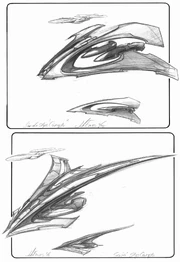
February 1998 design concepts for the Son'a battle cruiser
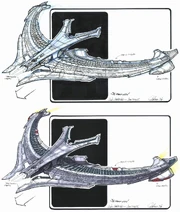
May 1998 finalized design concepts for the Son'a battle cruiser
Eaves started work on the battle cruiser in February 1998, after he finished up on Ru'afo's ship, and like that ship, he originally intended to have the battle cruiser fly with the forks forward, as he felt that "(...) it looked more aggressive." (The Secrets of Star Trek: Insurrection, p. 87) However, when the design for Ru'afo's ship was under evaluation, Co-Producer's Peter Lauritson predilection of having the ship fly in the opposite direction meant, that the flight direction of the battle cruiser was also reversed. Eaves has further noted on his designs, "With the battle cruiser, that was basically designed around a boomerang. It was kind of a forward reaching boomerang, and in comparison, all the ships had a kind of morph shape to them. Ru'afo's ship, if you spread it out, would be the boomerang shape, and if you would fold it in, it would be the Collector ship. So they had all kind of a similar shape, just in different proportions if spread out or vice versa. Everything we did for it was based on a kind of a flat plane. So from a forward point of view, everything was kind of horizontal in design." (Star Trek: Insurrection (Special Edition DVD), special feature "The Art of Insurrection") The flat, horizontal plane profiles, especially those of the battle cruiser, caused some initial concerns, but as Eaves further elaborated, "Since the Son'a are highly aggressive, I built the whole thing using shapes that reflected those tendencies–principally horseshoes and boomerangs. The resulting flatness was a concern to some, so I tried tipping it up and putting it on a vertical axis–something that doesn't happen very often with ships in the Star Trek universe. But that wound up being unnecessary, since the animatics demonstrated that anytime a ship started banking, it would no longer just be a flying blade on the verge of disappearing against the background." (Cinefex, issue 77, p. 79)
The discussion about the flight direction of the Son'a ships, delayed the further refinement on the design of the battle cruiser, with Eaves starting in the mean time on the designs of the Son'a shuttle and the collector ship, before finishing up on his design work on the battle cruiser in May 1998, conceding that, "The battle cruiser is a combination of the other Son'a ships. It's big, with one prong that's similar to the science vessel's, and it's spread out like Ru'afo's ship. But instead of being a horseshoe, it's more of a boomerang." At one point, the smooth top of the ship was briefly considered as the launching pad for the Son'a shuttles, but that never came to fruition. (The Secrets of Star Trek: Insurrection, p. 89)
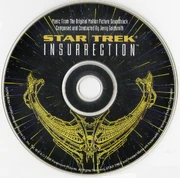
CD-soundtrack imprint
Eaves was a bit disappointed that relatively few visuals of his design of the battle cruiser made it into the final cut of the feature, but he had an unexpected boon when one of his design sketches showed up on a related licensed product, "When the film came out I was surprised at how few shots there were of this one and it was more of distant pov so you never really got to see what the vessel was made of.(...)My Friend Mark Banning was the art director over at Cresendo records and he [k]new I was a big fan of Jerry’s music and I can’t thank him enough for putting the plan drawings of the Sona Battle ship on the CD. That was another giddy fan boy moment." [3]
CGI model
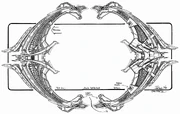
Orthographic views of the Son'a battleecruiser
The movie Insurrection, was the first feature film were it was conceived that all the visual effects would be executed as computer-generated imagery (CGI). At that point in time, the technique was still relatively new, and the workload entailed in creating these effects was such that it was decided to employ two effects houses for their creation; Blue Sky/VIFX, was contracted to provide all planet bound effects, as well as the interior Son'a collector visuals (and, as it turned out during production, its destruction as well), whereas Santa Barbara Studios (SBS) would be responsible for all the space bound visuals. The construction of the Son'a battle cruiser therefore fell to SBS. SBS' Effects Supervisor John Grower stated, "John sent us elevation views and one or two ¾ perspective drawings of each ship, but we had to do a lot of deduction work. The Son'a Flagship and Battleships had very complex shapes and all of these incredible compound curves, which didn't appear in the plan views. They're thin in one dimension and very wide and long in the other, kind of like a trilobite. The biggest challenge was that the Son'a ships didn't look the same from one angle to the next, so if we rotated around them a little bit, their profile changed because they had hundreds of compound curves that hooked together to form their shape. Getting it all to flow involved a ton of work and a very long modeling process." Apart from the intricate designs, creating digital ships on the computer was a labor, and time consuming effort from a technological standpoint as well, given the state of CGI technology at the time, as Grower further recalled, "Each ship was made up of lots of nurb surfaces, and the databases were hundreds of megabytes per ship. These models were very heavy, but Maya [remark: the CGI software package of choice at SBS] allowed us to efficiently structure and organize the data. We went through several iterations [of the ship designs] before we got approval, and Maya helped a lot there as well. Once we got the ships approved, of course, we had to make them look real." (American Cinematographer, January 1999, pp. 41-42)

Detail design sketches for SBS

SBS' CGI model of the Son'a battle cruiser
Eaves' approach to designing, adopted from his Star Trek: Deep Space Nine experiences, was a very cooperative one, meaning he usually only submitted ¾ views of his designs, allowing the digital modelers at the visual effects houses to enhance upon his designs, using their own imagination, as they saw fit, prompting a remark from Blue Sky's Carlyle Livingston, "John always tells you his drawings are just a guide that you can add to or subtract from as needed–which is a very generous attitude–." (Cinefex, issue 77, p. 84) Eaves intent did not play out as well as he had envisioned, or as he has put it, "Where with the ¾ drawings for ILM that would be basically what they would need and some rough plans, the CG-company that we were using, Santa Barbara, required a lot more drawings: top-views, side-views, plan views and a lot of other things that went with it, and it was also on a mental level trying to change from what a model couldn't do due to budget to what a computer model could." (Star Trek: Insurrection (Special Edition DVD), special feature "The Art of Insurrection") Though the SBS modelers lacked some of the confidence to employ their own imagination to the fullest, some original elements were imbued by them. The bronze hue imbued upon the model, in order to have the ships contrast with both the Starfleet vessels as well as the Briar Patch was an initiative of the SBS modelers. (Cinefex, issue 77, p. 79)
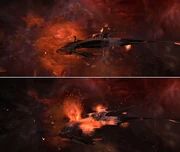
CGI model hit by a physical model
Even after the CGI model of the battle cruiser was constructed, when it came to the battle within the Briar Patch, SBS, at the time, was not confident enough to have certain sections of the sequence played out wholly in CGI. Though certain visual effects, especially those of explosions and fire, executed as CGI effects, were by then commonplace for the television franchise, especially Deep Space Nine, that was not yet the case for big-screen motion picture productions. The scene, 215, itself read , "EXT. NEBULA - THE ENTERPRISE - (OPTICAL) turning away as the Son'a ships fire and wham, the gases erupt... the Enterprise careens away out of control as the Son'a ships are hit by the explosion's full force. Both catch seriously on fire. After a beat, one explodes into bits... the other one sits there, helplessly on fire..." The moment the USS Enterprise-E destroys one of the battleships, a piece of it blows back into the other one, severely damaging it. SBS subcontracted O'Connor FX to provide additional pyrotechnics visual effects for the scene. Company's operators Ian, and Sherry O'Connor built a black steel part of the Son'a vessel, measuring about five by six feet, rigged it up for pyro destruction, had it filmed at The Chandler Group by Effects Cinematographer Don Baker, and had it subsequently detonated 25 feet above-ground in open air to allow sufficient space for the resulting zero-G explosion effect. Footage of it was sent to SBS to be inserted into the final cut. At SBS, CGI debris was also added, "I took a part from the first ship and rebuilt it as 3-D geometry, filled with girders. I blasted this piece backward into the second ship, then animated it shattering into smaller pieces of debris that also impact and set off secondary explosions.", SBS' Animation Supervisor James Strauss recollected. At a later stage, the visual footage was even embellished further, "We kept the big O'Connor pyro from the debris hit, but at HGI's suggestion, we added a kind of shockwave traveling through the vessel. That led to another O'Connor explosion blowing out the back side of the ship, which faces camera.", as related by SBS' Animator Mark Wendell. (Cinefex, issue 77, p. 88)
Though later mentioned in the Star Trek: Deep Space Nine television series, the Son'a would never again be featured, nor would any of their ships, so the CGI models were not upgraded in the LightWave 3D CGI software, and have not been featured ever since.
